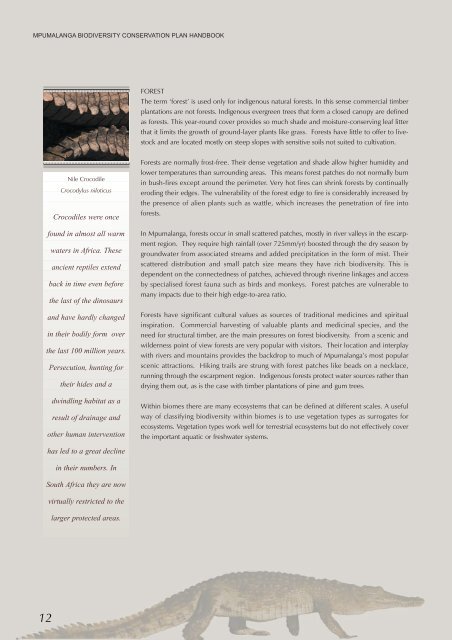Mpumalanga Biodiversity Conservation Plan Handbook - bgis-sanbi
Mpumalanga Biodiversity Conservation Plan Handbook - bgis-sanbi
Mpumalanga Biodiversity Conservation Plan Handbook - bgis-sanbi
Create successful ePaper yourself
Turn your PDF publications into a flip-book with our unique Google optimized e-Paper software.
MPUMALANGA BIODIVERSITY CONSERVATION PLAN HANDBOOK<br />
12<br />
Nile Crocodile<br />
Crocodylus niloticus<br />
Crocodiles were once<br />
found in almost all warm<br />
waters in Africa. These<br />
ancient reptiles extend<br />
back in time even before<br />
the last of the dinosaurs<br />
and have hardly changed<br />
in their bodily form over<br />
the last 100 million years.<br />
Persecution, hunting for<br />
their hides and a<br />
dwindling habitat as a<br />
result of drainage and<br />
other human intervention<br />
has led to a great decline<br />
in their numbers. In<br />
South Africa they are now<br />
virtually restricted to the<br />
larger protected areas.<br />
FOREST<br />
The term ‘forest’ is used only for indigenous natural forests. In this sense commercial timber<br />
plantations are not forests. Indigenous evergreen trees that form a closed canopy are defined<br />
as forests. This year-round cover provides so much shade and moisture-conserving leaf litter<br />
that it limits the growth of ground-layer plants like grass. Forests have little to offer to livestock<br />
and are located mostly on steep slopes with sensitive soils not suited to cultivation.<br />
Forests are normally frost-free. Their dense vegetation and shade allow higher humidity and<br />
lower temperatures than surrounding areas. This means forest patches do not normally burn<br />
in bush-fires except around the perimeter. Very hot fires can shrink forests by continually<br />
eroding their edges. The vulnerability of the forest edge to fire is considerably increased by<br />
the presence of alien plants such as wattle, which increases the penetration of fire into<br />
forests.<br />
In <strong>Mpumalanga</strong>, forests occur in small scattered patches, mostly in river valleys in the escarpment<br />
region. They require high rainfall (over 725mm/yr) boosted through the dry season by<br />
groundwater from associated streams and added precipitation in the form of mist. Their<br />
scattered distribution and small patch size means they have rich biodiversity. This is<br />
dependent on the connectedness of patches, achieved through riverine linkages and access<br />
by specialised forest fauna such as birds and monkeys. Forest patches are vulnerable to<br />
many impacts due to their high edge-to-area ratio.<br />
Forests have significant cultural values as sources of traditional medicines and spiritual<br />
inspiration. Commercial harvesting of valuable plants and medicinal species, and the<br />
need for structural timber, are the main pressures on forest biodiversity. From a scenic and<br />
wilderness point of view forests are very popular with visitors. Their location and interplay<br />
with rivers and mountains provides the backdrop to much of <strong>Mpumalanga</strong>’s most popular<br />
scenic attractions. Hiking trails are strung with forest patches like beads on a necklace,<br />
running through the escarpment region. Indigenous forests protect water sources rather than<br />
drying them out, as is the case with timber plantations of pine and gum trees.<br />
Within biomes there are many ecosystems that can be defined at different scales. A useful<br />
way of classifying biodiversity within biomes is to use vegetation types as surrogates for<br />
ecosystems. Vegetation types work well for terrestrial ecosystems but do not effectively cover<br />
the important aquatic or freshwater systems.

















